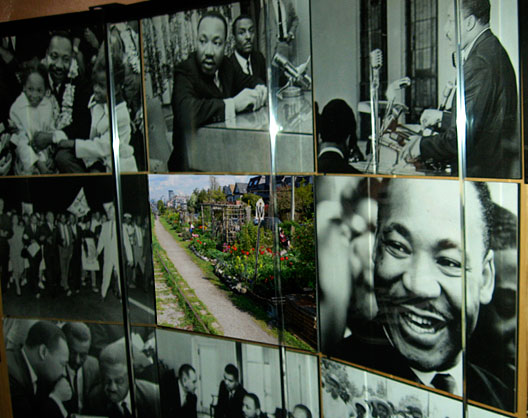 Martin Luther King, Jr. was a big fan of pie, supposedly. (And who isn’t?) A few years ago, Austin, Texas artist Luanne Stovall was baking a buttermilk one in honor of the civil-rights activist and decided to turn sharing it into a vehicle for peace and reconciliation on Martin Luther King, Jr. Day. Now, she calls these reinvented pie socials “Peace Through Pie,” and those who bring pies to share and engage in conflict resolution are “pie-o-neers.”
Martin Luther King, Jr. was a big fan of pie, supposedly. (And who isn’t?) A few years ago, Austin, Texas artist Luanne Stovall was baking a buttermilk one in honor of the civil-rights activist and decided to turn sharing it into a vehicle for peace and reconciliation on Martin Luther King, Jr. Day. Now, she calls these reinvented pie socials “Peace Through Pie,” and those who bring pies to share and engage in conflict resolution are “pie-o-neers.”
The internets tell me that pecan was King’s favorite pie, as it is mine. Or at least it was until I read The Omnivore’s Dilemma a few years ago and freaked out about corn syrup. I pitched my bottle of Karo right into the trash, and resolved to make my traditional Thanksgiving pecan pie with honey or maple syrup or even just brown sugar.
Well, I tried all three variations, and they were all just … wrong. The consistency was grainy or powdery, and they tasted too much like whatever sweetener I was using. I missed the dark, rich caramel flavor of the pecan pie I’ve been eating all my life, that my Florida great-grandmother made.
Then someone finally clued me in that there’s a big difference between corn syrup like Karo and high-fructose corn syrup. The short version: Corn syrup, invented in 1882, is primarily glucose suspended in water. Using it in baking prevents sugar crystals from forming — as happened with my honey version. Meanwhile, high-fructose corn syrup, invented in 1957, is a much more industrial product comprising fructose and glucose in varying ratios, some of which the body may treat differently than table sugar. (This guy Brian Geiger at FineCooking.com explains the chemistry differences in interesting detail.)
I’ve decided to allow Karo back into my cupboard, although I’m tempted to try making my own cane-sugar syrup, as this corn-syrup-fearing recipe from Apartment Therapy suggests, just to see how that tastes.
So, in the spirit of “Peace Through Pie,” I share with you my great-grandmother’s recipe, which the Southern side of my family has been eating for decades and decades.
Myrtle Kosh, my nana, lived into her 90s. She was a sharecropper’s daughter from the Florida panhandle with a second-grade education. For years she grew a lot of her own vegetables, milked her own cow, caught and fried up catfish, and made fearsomely good biscuits and collard greens. She grew up dirt-poor and clawed her way into middle-class respectability, and she was not a fan of the civil-rights movement or affirmative action. She was cheap — as her daughter said, if she sent you to the store with $20 and there was a quarter left over, she expected it back — and not particularly cheerful, but she was always generous with her cooking.
I think the secret to this pie, which is nuttier and less cloyingly sweet than most pecan pies, is in the low-and-slow baking.
Myrtle’s Pecan Pie
1 pie crust (I use Mark Bittman’s recipe for Flaky Pie Crust; you should prebake 10-15 minutes for best results.)
3 eggs
1 c. white Karo syrup
1 cup light brown sugar
1 stick butter, melted
1 teaspoon vanilla
2 cups pecans (1 cup chopped, 1 cup halves)
Pinch of salt
Prebake pie crust 10 minutes (pricked and using pie weights or something else to preserve its shape). Turn oven to 350.
Mix eggs with sugar, Karo, and butter.
Add the 1 cup chopped pecans and the vanilla, stirring to coat well.
Pour into pie shell. Add pecan halves, pushing under mixture to coat with syrup.
Bake at 350 for 10 minutes; turn heat down to 275 and finish off for about an hour or until pie center does not quiver when gently shaken.
Cross-posted with the Ethicurean




